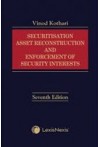- Author(s): Vinod Kothari
- Publisher: LexisNexis
- Edition: 7 Ed 2024
- ISBN 13 9789395116893
- Approx. Pages 1484 + contents
- Format Hardbound
- Approx. Product Size 24 x 16 cms
- Delivery Time 3-5 working days (within Kerala & South India) (Others 7-9 days)
- Shipping Charge Extra (see Shopping Cart)
.........................................................................................................................
Description
The SARFAESI Act would be 22 years of age by this time. It is important to think of what has been the efficiency of the law. Clearly, this law was not intended as a part of the country's basic legal infrastructure, or to define some basic rights and duties of parties to a credit transaction. The law was largely remedial - to achieve some particular object, in a particular set of circumstances.
The law had primarily two objectives - one, to move from pre-SARFAESI judicial recovery system, characterised by time and value losses in long drawn litigation, to a non-judicial creditor remedy regime, and secondly, to create the institution of private capital driven stressed-loan focused agencies, in form of the asset reconstruction companies, and to create a secondary market in stressed loans. As for the first objective, the scenario that existed before the enactment of the law has changed drastically over the years. The banking system in the country was reeling under the burden of non-performing loans - the GNPA ratio stood at approx. 11.4% in 2000-01 period. Since the enforcement of security interests was necessarily through the courts, the borrower would use the judicial delays as the instrument for stalling recoveries and drag the matter for years. Most of the loans were corporate loans, as banks' exposure to retail lending was not very significant at that time.
Coming to 2023-24, the scenario has changed dramatically. Corporate GNPA ratio has fallen to less than 2%. The stock of bad corporate loans built up over the era of what was called "zombie banking" has come down drastically.
No, it is not SARFAESI alone which has solely caused this change. There are numerous factors. First of all, the state of the economy itself has changed a lot. Companies are a lot more agile and efficient; labour markets have become much less unrestful; logistics are much better connected; Indian companies are globally more competitive. Generally speaking, loans wouldn't go bad if the business is good, because successful businesses look forward to continued trust of the lenders and try not to default.
.........................................................................................................................
Contents
Part I : Introduction to Securitisation, Asset Reconstruction and
Enforcement of Security Interest
Chapter 1 : Introduction to Securitisation
Chapter 2 : The Indian Securitisation Market
Chapter 3 : RBI's Guidelines on Securitisation of Performing Assets
Chapter 4 : Taxation of Securitisation Transactions in India
Chapter 5 : Non-Performing Loans-A Global Problem
Chapter 6 : Asset Management Companies and Resolution of NPLs
Chapter 7 : Non-Performing Loans-A Slew of Measures
Chapter 8 : Asset Reconstruction Companies in India : Genesis and Performance
Chapter 9 : Law and Practice of Asset Reconstruction in India
Chapter 10 : Introduction to Global Laws on Security Interests
Chapter 11 : Debt Recovery Law in India: An Overview
Part II : Securitisation and Reconstruction of Financial Assets and Enforcement
of Security Interest Act, 2002
Chapter 1 : Preliminary
Chapter 2 : Regulation of Securitisation and Reconstruction of Financial
Assets of Banks and Financial Institutions
Chapter 3 : Enforcement of Security Interest
Chapter 4 : Central Registry
Chapter 5 : Offences and Penalties
Chapter 6 : Miscellaneous
Part III : Subordinate Law (Rules, Directions, etc.) With Comments
1. Security Interest (Enforcement) Rules, 2002
App. I : Panchnama
App. II : Inventory
App. II A : Sale Notice
App. III : ertificate of Sale
App. IV : Possession Notice
App. IV A : Sale Notice
App. IV A : Form
App. VII : Application Under Sub-Section (1) of Section 17 to the Secularization and Reconstruction
of Fixed Assets and Enforcement of Security Interest Act, 2002
App. VIII : Application Under Sub-Section (6) of Section 17 of the Securitisation and Reconstruction
of Financial Assets and Enforcement of Security Interest Act, 2002
App. IX : Appeal Under Section 18 of the Securitisation and Reconstruction of Financial Assets and
Enforcement of Security Interest Act, 2002
App. X : Application Under Sub-Section (1) of Section 17 Read with Sub-Section (4) of Section 17 of the Act
2. Securitisation and Reconstruction of Financial Assets and Enforcement of Security Interest (Central
Registry) Rules, 2011
3. SAFAESI Act (Removal of Difficulties) Order, 2004
Subject
.........................................................................................................................
Author Details
Vinod Kothari : Chartered Accountant, Chartered Secretary,
Director, Indian Securitisation Foundation,
Mr. Vinod Kothari is a Chartered Accountant and a Company Secretary. He is internationally recognized as an author, trainer and consultant on specialized financial subjects, viz., housing finance, securitisation, credit derivatives, accounting for financial instruments, structured finance, banking regulations etc. He has delivered lectures and trained people on finance and securitization throughout the world. He leads his own firm Vinod Kothari and Company, which has its offices in Kolkata, Mumbai and Delhi. Currently, he holds the position of Director in Vinod Kothari Consultants Private Limited and Indian Securitization Foundation.
....................................................................................................................

